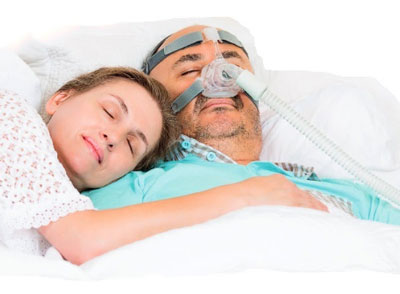Sleep apnea ans snoring

Snoring is a sound of varying intensity that results from vibrations of the throat tissue, soft palate and tongue as you take in air.
Sleep apnea occurs when you stop breathing.
This is accompanied by a decrease in oxygen levels in the blood.
Apnoea is three times more common in men than in women. Obese people, post-menopausal women and people aged between 40 and 65 are more likely to have apnoea.
Anatomical disorders can also cause apnoea, such as a thick soft palate, an enlarged tongue (macroglossia), large tonsils, nasal obstruction, a narrow palate, a receding mandible and/or maxilla.
Lifestyle factors such as smoking, alcohol consumption and sleeping pills can also influence the course of apnoea.
Among the diseases exacerbated or caused by sleep apnea, hypertension is the most common (hypertension difficult to control), diabetes (type 2), obesity, depression, loss of libido, concentration and memory disorders.
Cardiovascular complications are very important in hypertension in 60 to 90% of patients. The risk of stroke is also multiplied by 2 to 3 times.
Recent studies have shown a link between sleep apnea and Alzheimer’s disease.
The risk of accidents (driving, at work) is very high. In fact, driving accidents can be up to 15 times higher than the ordinary population.
Suspicion of sleep apnea is based on a thorough collection of signs and symptoms. Intense snoring and apnea are most often observed by the partner. Symptoms of excessive daytime sleepiness are very common (drowsiness or falling asleep at any time of the day).
Other symptoms may be present: headaches, libido disorders (lack of sexual interest), concentration and memory disorders, dry mouth, chronic nasal congestion (chronic cold), nocturia (increased frequency of urination at night), nightmares, sleepwalking, irritability. The patient may sometimes present symptoms suggestive of depression, rapid muscle fatigue during exercise, clumsiness in daily activities, attention disorders.
The diagnosis is made by performing a polysomnography (tests performed during sleep while hospitalized). In order to determine the stage of severity of the disease, polysomnography allows the calculation of the number of apnea-hypopnea per hour. A mild case of sleep apnea-hypopnea is characterized by an average number of 5 to 15/hour, an average case between 15 to 30/hour, and severe when these exceed 30/hour.
What are the treatment options?
The treatment will aim at correcting snoring and apnea in order to prevent secondary complications due to sleep disorders, breathing problems and blood oxygenation.
The success of the treatment is mainly based on the principles of lifestyle and diet, such as weight reduction, stopping smoking and alcoholic drinks. Sleeping pills are contraindicated because of possible depression of the respiratory center.
The primary treatment for sleep apnea is CPAP (Continuous Positive Airway Pressure).
The insufflation of air through a mask connected to a compressor allows to maintain the upper airways open at all stages of the respiratory cycle.
This treatment is effective, but sometimes poorly tolerated by the patient, requiring special attention to patient compliance.
Indeed, in order to obtain a satisfactory result, it must be used for at least 5-6 hours/night.


When CPAP is poorly tolerated or when propulsion (advancement) of the mandible shows satisfactory results, the use of a MGO (mandibular advancement orthosis) may be indicated.
This tooth-supported appliance allows the mandible to be advanced, thus increasing intraoral space and the opening of the upper airway.
Dental appliances are particularly indicated in cases of snoring, mild to moderate apnea, without many symptoms, or when CPAP fails.
Surgery can also be performed for the treatment of sleep apnea syndrome, especially in cases of obvious anatomical abnormalities.
These operations concern the soft tissues (tongue, palate, throat and bone structures).
The maxillofacial surgeon may propose a surgical treatment but a complete assessment of the bone and dental structures should be performed in order to evaluate the possibility or not of a jaw intervention.
Depending on the maxillofacial dysfunction, different interventions can be performed such as: palatal distraction, Lefort I advanced osteotomy, Dalpont-Obwegeser advanced osteotomy.
These procedures are listed in the orthognathic surgery section.
